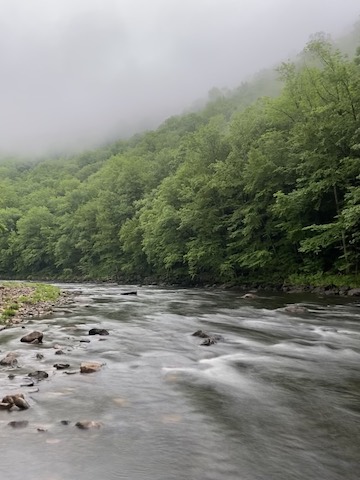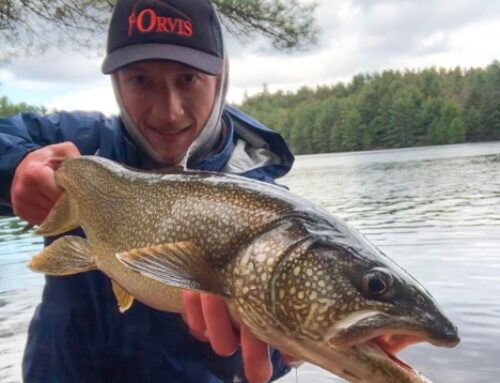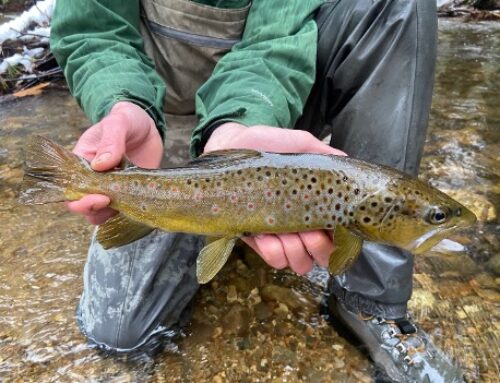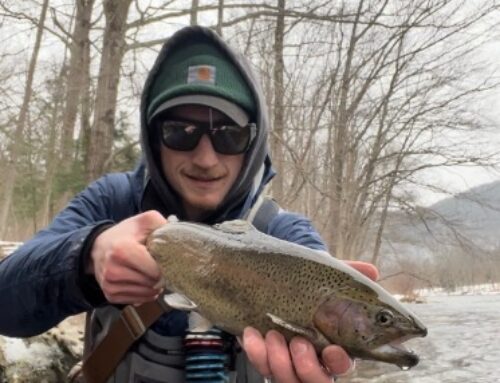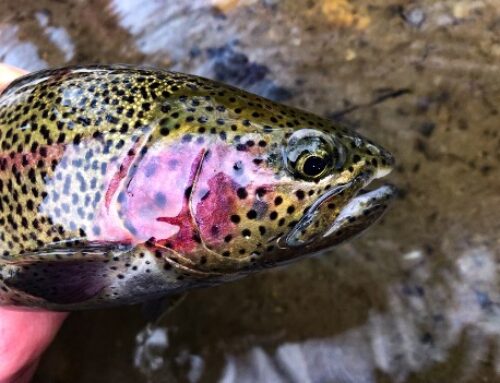It’s been an interesting summer. The wettest June on record has been followed up with a pretty rainy August mixed with some very hot and humid weather. We were spared the worst of both Henri and Ida (our thoughts are with those areas that were less fortunate).
Even though we dodged the brunt of those storms, we have gotten some rain for sure. Our rivers are running high and have been pretty much all season. The good news is that water temperatures have been kept down with all this water in the systems and for the most part have remained well within trout comfort zones much of this summer. The mixed news is that the high water has made wade angling tricky, particularly on the Deerfield, but this has kept angling pressure and bird predation down. All this adds up to what should be a spectacular next few months for trout fishing!
Those who have gotten out have found generally good angling. The trout are pretty spread out due to the high water levels. When you find them, they have been pretty willing to take flies. Big hopper and stonefly dry patterns like Chubby Chernobyls and Stimulators have been working well up top. Other terrestrials like ants and beetles are also working.
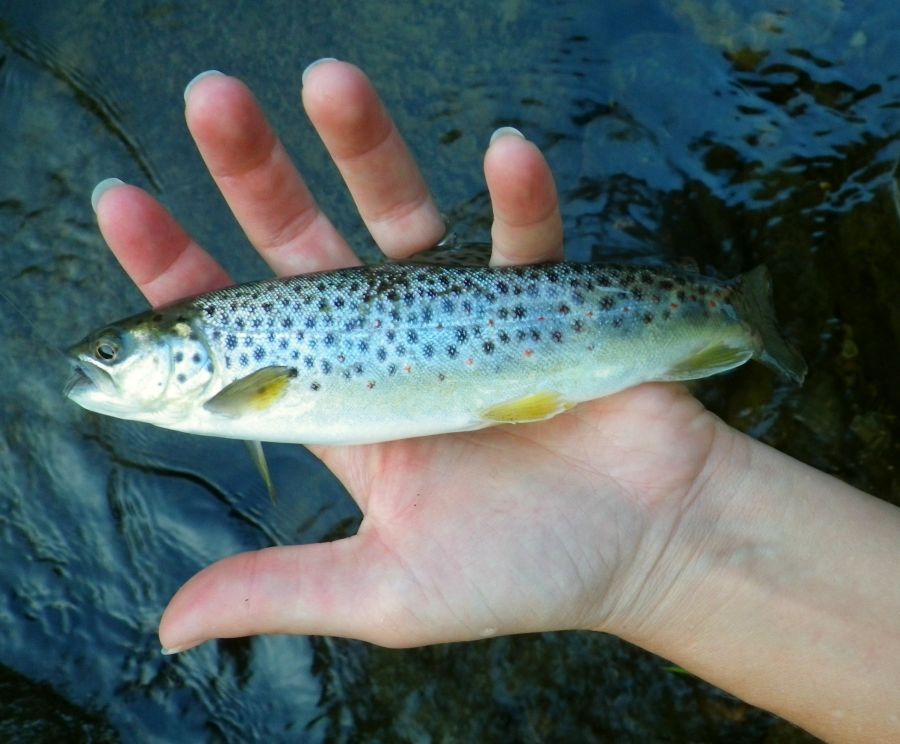
I have experienced, and also received many reports of, unusually high numbers of juvenile trout being caught on the Deerfield this season, both rainbows and browns. These fish are almost certainly stream bred. This is a great sign for our fishery. If we follow good fish handling and catch and release practices, these fish will become big, wily wild fish in the years to come. The Deerfield River Watershed chapter of Trout Unlimited, along with the Mass. Dept. of Fish and Wildlife, has been doing amazing work studying these populations and collecting hard, scientific data which can be used to plead our case both with DFW and the power companies that control the dams for better fish management and water flow policies that will benefit these wild fish. I highly encourage you to treat these wild fish with the utmost care. See www.keepfishwet.org for some great, scientifically informed practices and tips for best handling fish. Or stop by the shop and ask. I also encourage you to become a member of the Deerfield River Watershed chapter of TU if you are not already a member. If you join directly through the chapter it receives a greater share of your membership dues that it can put to use improving the fisheries in our area. See https://deerfieldrivertroutunlimited.com/
It is the time of year for flying ant hatches as well. This can be quite an event with spent ants literally carpeting the river surface. The fish can get very selective, particularly on size, for these ants as they have so many naturals to choose from. I like to have a good supply of flies from size 14 down to 20 in both black and cinnamon. Muggy, overcast days seem to be the best days for good hatches. I don’t know if these ants are high in protein or just taste good, but the trout can really go nuts on them.
Swinging wetflies has been effective. Soft hackles work well from size 12 to 16. Nymphing is always good on the Deerfield. From big stoneflies like Pat’s Rubber Legs and Terminator Stones to general all purpose nymphs like pheasant tails, hare’s ears, caddis larvae and prince nymphs from 12 to 18. I like to fish two nymphs. In bigger water I will anchor the system with a large stone and then trail a smaller nymph from the list above. In skinnier water I tend to anchor my rig with a size 12 PT or hare’s ear and trail it with something smaller. I will also work gilled nymphs to imitate Isos, zebra midges, caddis pupae, smaller BWOs and soft hackles into my rotation until I figure out what they are hitting on any given day. Dropping a size 12 curved PT called a Quasimodo off my hopper patterns has been good to me as well.
Look for our fall hatches to start soon as well. Isonychias are around and will become more and more important. Cahills can be found hatching at or after dark, but this hatch should start to move more toward earlier evening hours in the coming weeks and provide some good dry fly action. BWOs will be found on cooler and overcast days. Caddis are almost always around from 14s to 20s. The October Caddis should start showing in the next few weeks as well.
We are offering two new classes in October! On Thursday, October 14, starting at 4 pm, FFI-certified casting instructor Jim Dowd will lead an advanced casting clinic on improving distance and accuracy, focusing on mastering the double haul and the saltwater quick cast. On Saturday, Oct. 16 and Sunday, Oct. 17, we will be offering a co-ed version of our highly successful introduction to fly fishing retreat. Modeled on our women’s only retreats in May and July, this clinic open to all has two components. On Saturday, Cynthia Harkness of Fearless Fly Fishing leads the introductory session covering all that you will need to know to get going in fly fishing, from the jargon to trout behavior to knots to the fundamentals of casting a fly rod. On Sunday we take to the water on a half-day float with our professional guides where you can put all you’ve learned to work on the trout of the Deerfield River! There is limited space in both so sign up soon by contacting brian@deerfieldflyshop.com or calling the shop.
Area freestones like the Westfield and North come down to wadeable levels quick and provide good fishing. All this water has these rivers at temperatures that are still well within a trout’s comfort zone. Do keep an eye on water temps though if you plan on releasing your fish. As they approach 70 degrees, a released trout’s chance of survival diminishes significantly. I would suspect once the Miller’s River gets down to more moderate levels (between 100 and 400 cfs on the Erving gauge) it could provide some good action as long as we get cool nights and moderate days.

The Swift River is generally impervious to rain and remains at consistent levels and cool temps. This is one of the rare times of year on the Swift where you can do fairly well on larger flies like ants, beetles and hoppers. At other times, small midges (22-26 or even smaller) are often the answer, and small pheasant tails (18-22) and midge nymphs like Zebra midges (20-24) are also effective.
Bass fishing has been terrific lately, as it has been all summer. River smallies have been somewhat hit or miss as the rivers have been hard to fish at times, but when you hit it right the action can be nothing short of outstanding. For streamers, crayfish patterns fished deep can work well as can small to medium sized baitfish imitations like Clousers or Deceivers and olive or chartreuse. But the real excitement of bass fishing this time of year is topwater. Poppers and sliders can provide steady action with explosive takes. I like chartreuse or black on these topwater bugs though big chubbies can work on fish actively taking damselflies and dragon flies. The lower Deerfield, Millers and Westfield rivers are all excellent spots to wade fish for river smallies when the flows are down. The Connecticut is generally best fished from a boat, kayak or canoe and is home to many large smallmouth. There are too many ponds to list that harbor decent populations of largemouth bass.
Guided trips and lessons available. Call us at 413-397-3665 or email brian@deerfieldflyshop.com.
Dries: Chubby Chernobyls 6-10, Bank Beetle 10-14, Flying Ants 14-20, CDC Slate Drake 10-12, Parachute Hare’s Ear 12-16, Parachute March Brown 12-14, Midges, Parachute Adams 10 to 14; Parachute Mahogany Dun 16-18; Rusty Spinners 12-16, Elk Hair Caddis tan and Olive 14 to 18, Sedgehammer 14-16, Snowshoe caddis
Nymphs: Pat’s Rubber Legs, Golden or Black Terminator Stone 8-12, eggs, hares’ ears in natural and black 10-14, Pheasant Tail Nymphs 12-18, Frenchies 12-16, Tan/Olive Mops, Squirmies, Natural/Olive Caddis Pupae/Larvae 12-16, Red/Copper Johns 12-16, Sexy Walt 12-16, Gilled Nymph 10-14, Zug Bug 10 to 12.
Streamers: Woolly Buggers Olive/Black 6-10, White/Olive Sculpzilla 8,Bank Robber 2, Ice Picks, Heisenberg Baby Bow/Cowboy/White 6, Sculpin Bunny, Black/Brown Rubber Bugger 4, Black, white and olive Zonkers.
Water Flows for Fife Brook Dam can be found here
Water release schedule for the next day is posted after 5pm. Check again before you head to the river. Minimum Flow 130 CFS (Cubic Feet/Second). Ideal for wading and Dry Fly Action. Normal Release 800-1,000 CFS
Dam release for the #2 Dam in Buckland can be found here
For Miller’s River in Erving here
For Miller’s River Bear’s Den area here
For East Branch of the Westfield here


